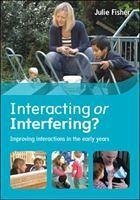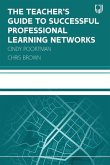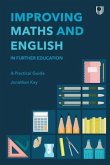- Broschiertes Buch
- Merkliste
- Auf die Merkliste
- Bewerten Bewerten
- Teilen
- Produkt teilen
- Produkterinnerung
- Produkterinnerung
Offers practical guidance on developing high quality interactions to better scaffold childrenâ s learning and development.
Andere Kunden interessierten sich auch für
![The Teacher's Guide to Successful Professional Learning Networks: Overcoming Challenges and Improving Student Outcomes The Teacher's Guide to Successful Professional Learning Networks: Overcoming Challenges and Improving Student Outcomes]() Cindy PoortmanThe Teacher's Guide to Successful Professional Learning Networks: Overcoming Challenges and Improving Student Outcomes53,99 €
Cindy PoortmanThe Teacher's Guide to Successful Professional Learning Networks: Overcoming Challenges and Improving Student Outcomes53,99 €![Improving the Psychological Wellbeing of Children and Young People Improving the Psychological Wellbeing of Children and Young People]() Improving the Psychological Wellbeing of Children and Young People42,99 €
Improving the Psychological Wellbeing of Children and Young People42,99 €![Improving Maths and English: In Further Education Improving Maths and English: In Further Education]() Jonathan KayImproving Maths and English: In Further Education42,99 €
Jonathan KayImproving Maths and English: In Further Education42,99 €![Improving the Lives of People with Dementia through Technology Improving the Lives of People with Dementia through Technology]() Improving the Lives of People with Dementia through Technology44,99 €
Improving the Lives of People with Dementia through Technology44,99 €![Early Years Pedagogy in Practice Early Years Pedagogy in Practice]() Ruksana BeigiEarly Years Pedagogy in Practice148,99 €
Ruksana BeigiEarly Years Pedagogy in Practice148,99 €![Transgenerational Technology and Interactions for the 21st Century Transgenerational Technology and Interactions for the 21st Century]() Hannah R. Marston (UK The Open University)Transgenerational Technology and Interactions for the 21st Century59,99 €
Hannah R. Marston (UK The Open University)Transgenerational Technology and Interactions for the 21st Century59,99 €![Weakly Interacting Molecular Pairs: Unconventional Absorbers of Radiation in the Atmosphere Weakly Interacting Molecular Pairs: Unconventional Absorbers of Radiation in the Atmosphere]() Claude Camy-Peyret / Andrei A. Vigasin (Hgg.)Weakly Interacting Molecular Pairs: Unconventional Absorbers of Radiation in the Atmosphere121,99 €
Claude Camy-Peyret / Andrei A. Vigasin (Hgg.)Weakly Interacting Molecular Pairs: Unconventional Absorbers of Radiation in the Atmosphere121,99 €-
-
-
Offers practical guidance on developing high quality interactions to better scaffold childrenâ s learning and development.
Hinweis: Dieser Artikel kann nur an eine deutsche Lieferadresse ausgeliefert werden.
Hinweis: Dieser Artikel kann nur an eine deutsche Lieferadresse ausgeliefert werden.
Produktdetails
- Produktdetails
- Verlag: Open University Press
- UK ed.
- Seitenzahl: 248
- Erscheinungstermin: 16. Januar 2016
- Englisch
- Abmessung: 238mm x 167mm x 17mm
- Gewicht: 424g
- ISBN-13: 9780335262564
- ISBN-10: 0335262562
- Artikelnr.: 44515140
- Herstellerkennzeichnung
- Libri GmbH
- Europaallee 1
- 36244 Bad Hersfeld
- gpsr@libri.de
- Verlag: Open University Press
- UK ed.
- Seitenzahl: 248
- Erscheinungstermin: 16. Januar 2016
- Englisch
- Abmessung: 238mm x 167mm x 17mm
- Gewicht: 424g
- ISBN-13: 9780335262564
- ISBN-10: 0335262562
- Artikelnr.: 44515140
- Herstellerkennzeichnung
- Libri GmbH
- Europaallee 1
- 36244 Bad Hersfeld
- gpsr@libri.de
Julie Fisher is an independent Early Years Adviser and visiting Professor of Early Childhood Education at Oxford Brookes University, UK.
1 The importance of interactions for young children's learning Introduction
Different definitions of 'effectiveness' Interactions in the home Why
interaction matters Why interactions matter to children entering school Why
interactions matter to practitioners Summary
2 Interacting with babies and toddlers Introduction The foundations of
interaction The development of interactions Summary
3 Knowing the child well Introduction Focus on babies and toddlers What
practitioners need to learn about children The importance of the Key
Persons Approach The impact of knowing children well Talking to someone and
not everyone Analysing your own practice Transcripts: knowing the child
well Transcripts 3:1; 3:2 Summary
4 Environments conducive to conversation Introduction Focus on babies and
toddlers Emotional space Physical space Analysing your own practice
Transcripts 4:1; 4:2 Summary
5 Tuning in to the child Introduction Focus on babies and toddlers The
child as a learner Strategies for tuning in to children Working out what a
child is thinking is more valuable than looking at what they are doing
Deciding when and whether to interact can be the difference between
interacting and interfering Analysing your own practice Transcripts 5:1;
5:2 Summary
6 Who leads the learning? Introduction Focus on babies and toddlers The
benefits of learning alongside an adult and learning independently
Independent learning is not abandoned learning Interactions in adult-led,
adult-initiated and child-led contexts The purpose of an interaction The
balance between adult-led and child-led learning Who leads the learning?
Analysing your own practice Transcripts 6:1 to 6:4 Summary
7 Sustaining effective interactions Introduction Focus on babies and
toddlers Initiating conversations Sustaining interactions Consolidating,
extending and provoking thinking Analysing your own practice Body language
Analysing your own practice Tone of voice Transcripts 7:1 to 7:7 Analysing
your own practice Summary
8 Interacting with children who might not want to interact Introduction
Focus on babies and toddlers Reluctant talkers Children with autism
Children with English as an additional language (Eal) Signing as a form of
communication Analysing your own practice Transcripts 8:1; 8:2 Summary
9 Questions that work and questions that don't Introduction Focus on babies
and toddlers Why do we ask questions? Who asks the questions? Transcripts
9:1 to 9:6 Different types of questions Using questioning as control
Children's answers Questions that work and questions that don't
Alternatives to questioning Analysing my own practice Transcripts 9:5 to
9:6 Summary
10 The attributes of effective practitioners Introduction Focus on babies
and toddlers The attributes of effectiveness The importance of reciprocity
Interacting not interfering Analysing your own practice Transcript 10:1
Summary
Different definitions of 'effectiveness' Interactions in the home Why
interaction matters Why interactions matter to children entering school Why
interactions matter to practitioners Summary
2 Interacting with babies and toddlers Introduction The foundations of
interaction The development of interactions Summary
3 Knowing the child well Introduction Focus on babies and toddlers What
practitioners need to learn about children The importance of the Key
Persons Approach The impact of knowing children well Talking to someone and
not everyone Analysing your own practice Transcripts: knowing the child
well Transcripts 3:1; 3:2 Summary
4 Environments conducive to conversation Introduction Focus on babies and
toddlers Emotional space Physical space Analysing your own practice
Transcripts 4:1; 4:2 Summary
5 Tuning in to the child Introduction Focus on babies and toddlers The
child as a learner Strategies for tuning in to children Working out what a
child is thinking is more valuable than looking at what they are doing
Deciding when and whether to interact can be the difference between
interacting and interfering Analysing your own practice Transcripts 5:1;
5:2 Summary
6 Who leads the learning? Introduction Focus on babies and toddlers The
benefits of learning alongside an adult and learning independently
Independent learning is not abandoned learning Interactions in adult-led,
adult-initiated and child-led contexts The purpose of an interaction The
balance between adult-led and child-led learning Who leads the learning?
Analysing your own practice Transcripts 6:1 to 6:4 Summary
7 Sustaining effective interactions Introduction Focus on babies and
toddlers Initiating conversations Sustaining interactions Consolidating,
extending and provoking thinking Analysing your own practice Body language
Analysing your own practice Tone of voice Transcripts 7:1 to 7:7 Analysing
your own practice Summary
8 Interacting with children who might not want to interact Introduction
Focus on babies and toddlers Reluctant talkers Children with autism
Children with English as an additional language (Eal) Signing as a form of
communication Analysing your own practice Transcripts 8:1; 8:2 Summary
9 Questions that work and questions that don't Introduction Focus on babies
and toddlers Why do we ask questions? Who asks the questions? Transcripts
9:1 to 9:6 Different types of questions Using questioning as control
Children's answers Questions that work and questions that don't
Alternatives to questioning Analysing my own practice Transcripts 9:5 to
9:6 Summary
10 The attributes of effective practitioners Introduction Focus on babies
and toddlers The attributes of effectiveness The importance of reciprocity
Interacting not interfering Analysing your own practice Transcript 10:1
Summary
1 The importance of interactions for young children's learning Introduction
Different definitions of 'effectiveness' Interactions in the home Why
interaction matters Why interactions matter to children entering school Why
interactions matter to practitioners Summary
2 Interacting with babies and toddlers Introduction The foundations of
interaction The development of interactions Summary
3 Knowing the child well Introduction Focus on babies and toddlers What
practitioners need to learn about children The importance of the Key
Persons Approach The impact of knowing children well Talking to someone and
not everyone Analysing your own practice Transcripts: knowing the child
well Transcripts 3:1; 3:2 Summary
4 Environments conducive to conversation Introduction Focus on babies and
toddlers Emotional space Physical space Analysing your own practice
Transcripts 4:1; 4:2 Summary
5 Tuning in to the child Introduction Focus on babies and toddlers The
child as a learner Strategies for tuning in to children Working out what a
child is thinking is more valuable than looking at what they are doing
Deciding when and whether to interact can be the difference between
interacting and interfering Analysing your own practice Transcripts 5:1;
5:2 Summary
6 Who leads the learning? Introduction Focus on babies and toddlers The
benefits of learning alongside an adult and learning independently
Independent learning is not abandoned learning Interactions in adult-led,
adult-initiated and child-led contexts The purpose of an interaction The
balance between adult-led and child-led learning Who leads the learning?
Analysing your own practice Transcripts 6:1 to 6:4 Summary
7 Sustaining effective interactions Introduction Focus on babies and
toddlers Initiating conversations Sustaining interactions Consolidating,
extending and provoking thinking Analysing your own practice Body language
Analysing your own practice Tone of voice Transcripts 7:1 to 7:7 Analysing
your own practice Summary
8 Interacting with children who might not want to interact Introduction
Focus on babies and toddlers Reluctant talkers Children with autism
Children with English as an additional language (Eal) Signing as a form of
communication Analysing your own practice Transcripts 8:1; 8:2 Summary
9 Questions that work and questions that don't Introduction Focus on babies
and toddlers Why do we ask questions? Who asks the questions? Transcripts
9:1 to 9:6 Different types of questions Using questioning as control
Children's answers Questions that work and questions that don't
Alternatives to questioning Analysing my own practice Transcripts 9:5 to
9:6 Summary
10 The attributes of effective practitioners Introduction Focus on babies
and toddlers The attributes of effectiveness The importance of reciprocity
Interacting not interfering Analysing your own practice Transcript 10:1
Summary
Different definitions of 'effectiveness' Interactions in the home Why
interaction matters Why interactions matter to children entering school Why
interactions matter to practitioners Summary
2 Interacting with babies and toddlers Introduction The foundations of
interaction The development of interactions Summary
3 Knowing the child well Introduction Focus on babies and toddlers What
practitioners need to learn about children The importance of the Key
Persons Approach The impact of knowing children well Talking to someone and
not everyone Analysing your own practice Transcripts: knowing the child
well Transcripts 3:1; 3:2 Summary
4 Environments conducive to conversation Introduction Focus on babies and
toddlers Emotional space Physical space Analysing your own practice
Transcripts 4:1; 4:2 Summary
5 Tuning in to the child Introduction Focus on babies and toddlers The
child as a learner Strategies for tuning in to children Working out what a
child is thinking is more valuable than looking at what they are doing
Deciding when and whether to interact can be the difference between
interacting and interfering Analysing your own practice Transcripts 5:1;
5:2 Summary
6 Who leads the learning? Introduction Focus on babies and toddlers The
benefits of learning alongside an adult and learning independently
Independent learning is not abandoned learning Interactions in adult-led,
adult-initiated and child-led contexts The purpose of an interaction The
balance between adult-led and child-led learning Who leads the learning?
Analysing your own practice Transcripts 6:1 to 6:4 Summary
7 Sustaining effective interactions Introduction Focus on babies and
toddlers Initiating conversations Sustaining interactions Consolidating,
extending and provoking thinking Analysing your own practice Body language
Analysing your own practice Tone of voice Transcripts 7:1 to 7:7 Analysing
your own practice Summary
8 Interacting with children who might not want to interact Introduction
Focus on babies and toddlers Reluctant talkers Children with autism
Children with English as an additional language (Eal) Signing as a form of
communication Analysing your own practice Transcripts 8:1; 8:2 Summary
9 Questions that work and questions that don't Introduction Focus on babies
and toddlers Why do we ask questions? Who asks the questions? Transcripts
9:1 to 9:6 Different types of questions Using questioning as control
Children's answers Questions that work and questions that don't
Alternatives to questioning Analysing my own practice Transcripts 9:5 to
9:6 Summary
10 The attributes of effective practitioners Introduction Focus on babies
and toddlers The attributes of effectiveness The importance of reciprocity
Interacting not interfering Analysing your own practice Transcript 10:1
Summary








